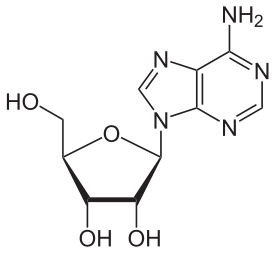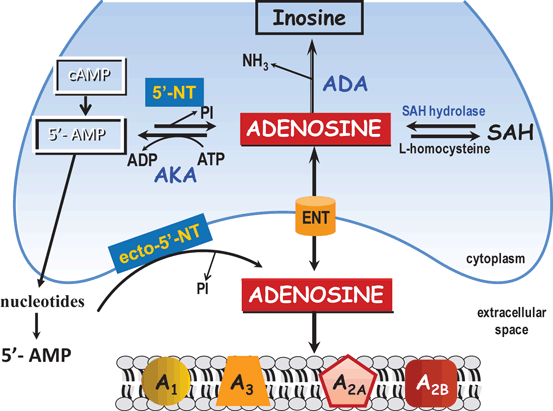Adenosine
links: Purine reference: 4-20-2021
Adenosine
 #
#
RiboNucleoside. Promotes NREM sleep. With regards to the Circadian Rhythm, I believe adenosine first binds to A2A and then no more remains, it binds to Adenosine A1 to promote sleep. Is an indirect neurotransmitter.
-
Adenosine in sleep and wakefulness (Porkka-Heiskanen, 2016)
- Adenosine builds up in the Basal Forebrain: a cholinergic structure and the hypothetical source of the neural homeostatic signal. When active/inactive it contributes to wakefulness and REM and sleepiness/NREM.
-

-
Enzymes of adenosine metabolism in the brain: diurnal rhythm and the effect of sleep deprivation
- Activity of adenosine deaminase increased during the active period in the ventrolateral pre-optic area but decreased significantly in the basal forebrain.
- Activity of adenosine kinase and cytosolic-5′-nucleotidase was higher during the active period in all brain regions tested.
- Rats are nocturnal, so these things are peaking at like 3AM. Maybe that’s 3PM for us, AKA siesta time.
- However, the activity of ecto-5′-nucleotidase was augmented during the active period only in the cerebral cortex.
-
Enzymes of adenosine metabolism in the brain: diurnal rhythm and the effect of sleep deprivation
- ATP $\ce{<=>}$ ADP $\ce{<=>}$ AMP $\ce{…\\ <=>[Adenoinse Kinase][5’-nucleotidase] Adenosine \begin{cases} <=>[S-adenosylhomocysteine hydrolase]S-adenosylhomocysteine \\ ->[Adenosine Deaminase]Inosine \end{cases}}$
-
The adenosine-mediated, neuronal-glial, homeostatic sleep response
- results from a buildup and decay of extracellular adenosine that acts at neuronal adenosine A1 receptors to facilitate SWA and is metabolized by adenosine kinase found in glia.
- Leaves the neuron via vesicular release, nucleoside transporters (bidirectional) and transmembrane channels (Pannexin/Connexin, which also transport nucleotides)
- Cell surface enzymes like the CD39/CD73 are E-NTPD-ases for both ATP->ADP->AMP and then 5’-nucleotidase respectively.
Glucose Homeostasis #
-
Adenosine, Adenosine Receptors and Their Role in Glucose Homeostasis and Lipid Metabolism
-
Adenosine signaling contributes to ethanol-induced fatty liver in mice
- Steatotic livers demonstrated increased expression of genes involved in fatty acid synthesis, which was prevented by blockade of adenosine A1 receptors, and decreased expression of genes involved in fatty acid metabolism, which was prevented by blockade of adenosine A2B receptors
- Removal of adenosine decreases the responsiveness of muscle glucose transport to insulin and contractions adenosine potentiates insulin- and contraction-stimulated glucose transport in skeletal muscle by enhancing the increase in GLUT4 at the cell surface
-
Adenosine A1 and A2a receptors modulate insulinemia, glycemia, and lactatemia in fetal sheep
- Hypoxia, which increases endogenous adenosine concentrations, induces hyperglycemia that is partly mediated by activation of A1 and A2A receptors
- Isocapnic hypoxia hx suppressed insulinemia and enhanced glycemia and lactatemia, but only the hyperglycemia was blunted by blockade of A1 or A2A receptors
- Normoxia and endogenous ADO: ZM-241385 (A2A antagonist) did not alter insulin levels; thus, A2A receptors are not significant modulators of insulin levels under these conditions.
- Normoxia and exogenous ADO: Sympathetic activity inhibits fetal insulin release through activation of α2-adrenergic receptors that modulate islet cell function. The ADO-induced reduction in insulin levels in the present study is consistent with an A2A receptor-mediated activation of sympathoadrenal pathways, which, in turn, blunt insulin release.
- Purinergic contribution to circulatory, metabolic, and adrenergic responses to acute hypoxemia in fetal sheep
- A2A activation suppresses macrophage TNF-α production, which is involved in glucose homeostasis: Shaping of monocyte and macrophage function by adenosine receptors
- Adenosine A2A receptors mediate hypoxic inhibition of fetal breathing in sheep explains reduced O2 consumption after ADO administration
- A2A increases gluconeogenesis and glucose release in hepatocytes.
- Adenosine A2A receptor occupancy stimulates expression of proteins involved in reverse cholesterol transport and inhibits foam cell formation in macrophages
- A2A activates reverse cholesterol transport via upregulating CYP27A1 and ABCA1; macriphages lacking A2A were not protected from foam cell formation by A2A antagonism. A2AKO = elevated serum cholesterol.
- A2A-KO does not alter basal glucose levels. It is possible that this receptor is more important under stress related conditions
-
Links Between Insulin Resistance, Adenosine A2B Receptors, and Inflammatory Markers in Mice and Humans
- Administration of an antagonist of the A2ARs (NECA) fed in combination with high fat diet resulted in an improved fasting glucose levels in wild type mice
- A1 and A2B KO mice (but not A2A) were protected from fatty liver development from ethanol
-
Adenosine signaling contributes to ethanol-induced fatty liver in mice